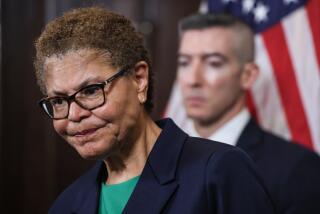When It Comes to Cities, Smaller Is Better
- Share via
Debating San Fernando Valley secession recently, a leader of One Los Angeles, an anti- secession group, said there was no such thing as a good or bad system, that good or bad people determined how government functioned. If you buy this view, the failure of the Soviet Union had nothing to do with the dictatorial nature of its socialistic system--it failed because the wrong people were running it.
It’s hard to fathom the view that the failure of local government in L.A. is a result of our inability to find a few good people to run it. Of course we know better; systems do matter. For one thing, the size and structure of government affect resident participation. In smaller cities, studies suggest that residents are more active and vote more. Princeton political scientist J. Eric Oliver found that residents in larger cities were less likely to contact officials or attend community or organizational meetings. A Public Policy Institute of California study that looked at voting in cities across the state found lower voter turnout in larger cities.
This means that residents in smaller cities more closely monitor government, making it harder for special interests--developers, public employee unions--to affect public policy. That subtly shifts the balance of power toward those residents who join the debate.
City size affects how public funds are spent. Because government officials encounter less scrutiny in large cities, money often is spent on projects and programs that serve special interests rather than pressing local needs. Rather than providing street lights in Pacoima, for example, the L.A. City Council chose to subsidize the 2000 Democratic National Convention.
In very large cities, where funds for community projects or infrastructure come from a citywide general fund, it can be said that communities are always spending other people’s money. This creates incentives to waste taxpayers’ money. Although there haven’t been many studies, a study of the Minneapolis and St. Paul area, reported in the academic journal Public Choice in 1983, found that when the commercial-industrial property tax base was shared broadly across the seven-county metropolitan area, local government spending increased.
The point is that incentives change as government size and structure change. Downsizing Los Angeles would encourage resident participation, increasing the voice of local residents in policy and spending decisions.
There is a potential secondary effect that could improve city services. Newly elected Valley politicians could choose to place control over services (garbage collection, tree trimming, police protection) and policy (land use and zoning) at the council district level. Local control would allow spending to more closely match the priorities of residents in an area. Because accountability is clear, local control facilitates monitoring of service providers and has the potential to improve services across the Valley.
Clearly, government size and structure affect public policy and service. Put all the members of One Los Angeles on the Los Angeles City Council and they would be subject to the same influences that current members face. It is not the people, it is the structure, and L.A. residents will have a once-in-a-lifetime chance to change that structure in November.
More to Read
Sign up for Essential California
The most important California stories and recommendations in your inbox every morning.
You may occasionally receive promotional content from the Los Angeles Times.










